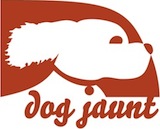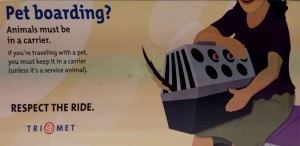I don’t have good news for you. At least three intercity bus companies, including Greyhound, allow only service dogs on board. Trailways — now a confederation of smaller bus lines — leaves the door open to traveling by bus with your dog by letting its constituent companies set their own policies. That said, I haven’t yet found a Trailways company that does allow pet dogs on board. Perhaps you’ll have more luck….
Greyhound Bus
Greyhound Bus does not allow dogs on board (except, of course, for service animals):
No dogs, cats, birds, or other animals will be transported. However, a service animal, trained for the purpose of accompanying a disabled person, will be permitted to travel with the disabled person at no additional charge.
I’m usually willing to consider smuggling a small dog into forbidden territories (see, for example, Dog Jaunt’s post on traveling by Amtrak), but I’ve traveled on enough Greyhound buses to know that the aisles are narrow and the seats are close together. There simply isn’t enough room to stow a dog in a carrier discreetly.
Other bus companies
Sadly, the same is true of Peter Pan Bus Lines, serving the Northeast (New York, New Hampshire, Massachusetts, Rhode Island, Connecticut, New Jersey, eastern Pennsylvania, Delaware, Maryland and Washington, D.C.), whose pet policy states:
No dogs, cats, birds, or other animals will be transported. However, a service animal, trained for the purpose of accompanying a disabled person, will be permitted to travel with the disabled person at no additional charge.
Megabus.com operates a no-frills bus system in the Midwest, Northeast and parts of Canada. Its pet policy too forbids dogs other than service animals:
Megabus.com is unable to carry dogs or other animals, with the exception of trained service animals that allow disabled passengers to perform necessary activities. Service animals must be properly harnessed and under the direct control of the passenger at all times.
[4/10/12 BoltBus, a Megabus competitor, operates buses in the northeastern U.S. A joint venture of Greyhound and Peter Pan, it too does not allow pets on board.]
Trailways
The situation potentially brightens when you look at Trailways‘ pet policy:
General or leisure pet travel aboard a Trailways bus, however, is at the discretion of each bus company operating the scheduled route service.
If pet transport is allowed by a Trailways bus company, the only animals which may be brought aboard the bus is either a cat or dog, which weighs less than 25 lbs, and must be securely contained in an official “Live” pet transport carrier.
If you are considering travel aboard a Trailways bus, and wish to transport a pet, you must contact the bus company operating the scheduled bus service in advance of arriving at the departure location for bus-boarding.
The task, then, is to identify which of Trailways’ member companies allows “leisure pet travel” (I like that phrase!). Here’s a link to the Trailways page that will help you get started.
The gloom descends, I have to warn you, as you start clicking. For starters, a lot of these companies offer only charter buses. Two of the companies that offer scheduled services and not just charters (Northwestern Trailways, New York Trailways) do not allow dogs on board. There are many companies in the group that I didn’t research, though, so perhaps you and your dog will strike gold.





 TriMet
TriMet
